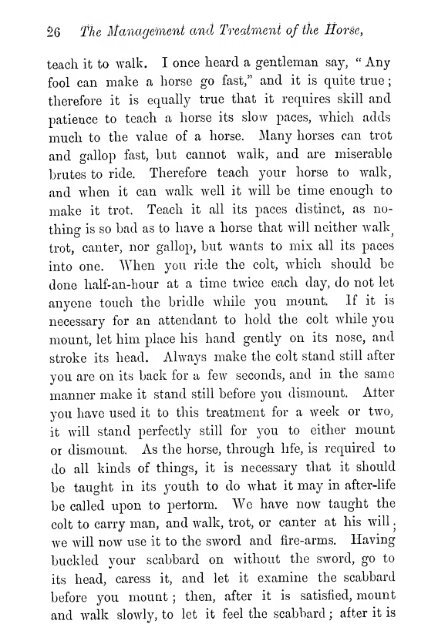The management and treatment of the horse in the stable, field, and ...
The management and treatment of the horse in the stable, field, and ...
The management and treatment of the horse in the stable, field, and ...
Create successful ePaper yourself
Turn your PDF publications into a flip-book with our unique Google optimized e-Paper software.
26 <strong>The</strong> Management <strong>and</strong> Treatment <strong>of</strong> <strong>the</strong> ttor$e,<br />
teach it to walk. I once heard a gentleman say, " Any<br />
fool can make a <strong>horse</strong> go fast/' <strong>and</strong> it is quite true ;<br />
<strong>the</strong>refore it is equally true that it requires skill <strong>and</strong><br />
patience to teach a <strong>horse</strong> its slow paces, which adds<br />
much to <strong>the</strong> value <strong>of</strong> a <strong>horse</strong>. Many <strong>horse</strong>s can trot<br />
<strong>and</strong> gallop fast, but cannot walk, <strong>and</strong> are miserable<br />
brutes to ride. <strong>The</strong>refore teach your <strong>horse</strong> to walk,<br />
<strong>and</strong> when it can walk well it will be time enough to<br />
make it trot. Teach it all its paces dist<strong>in</strong>ct, as no-<br />
th<strong>in</strong>g is so bad as to have a <strong>horse</strong> that will nei<strong>the</strong>r walk<br />
trot, canter, nor gallop, but wants to mix all its paces<br />
<strong>in</strong>to one. When you ride <strong>the</strong> colt, which should be<br />
done half-an-hour at a time twice each day, do not let<br />
anyone touch <strong>the</strong> bridle while you mount. If it is<br />
necessary for an attendant to hold <strong>the</strong> colt while you<br />
mount, let him place his h<strong>and</strong> gently on its nose, <strong>and</strong><br />
stroke its head. Always make <strong>the</strong> colt st<strong>and</strong> still after<br />
you are on its back for a few seconds, <strong>and</strong> <strong>in</strong> <strong>the</strong> same<br />
manner make it st<strong>and</strong> still before you dismount. Alter<br />
you have used it to this <strong>treatment</strong> for a week or two,<br />
it will st<strong>and</strong> perfectly still for you to ei<strong>the</strong>r mount<br />
or dismount. As <strong>the</strong> <strong>horse</strong>, through life, is required to<br />
do all k<strong>in</strong>ds <strong>of</strong> th<strong>in</strong>gs, it is necessary that it should<br />
be taught <strong>in</strong> its youth to do what it may <strong>in</strong> after-life<br />
be called upon to perlorm. We have now taught <strong>the</strong><br />
colt to carry man, <strong>and</strong> walk, trot, or canter at his will<br />
we will now use it to <strong>the</strong> sword <strong>and</strong> fire-arms. Hav<strong>in</strong>g<br />
buckled your scabbard on without <strong>the</strong> sword, go to<br />
its head, caress it, <strong>and</strong> let it exam<strong>in</strong>e <strong>the</strong> scabbard<br />
before you mount ; <strong>the</strong>n, after it is satisfied, mount<br />
<strong>and</strong> walk slowly, to let it feel <strong>the</strong> scabbard ; after it is
















